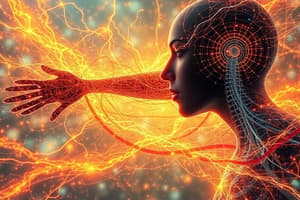Podcast
Questions and Answers
What does functional segregation in sensorimotor hierarchies imply?
What does functional segregation in sensorimotor hierarchies imply?
- Each level is composed of the same neural structures.
- Each level performs identical functions.
- Different cognitive processes are integrated at each level.
- Different units perform distinct functions. (correct)
How do sensorimotor systems use sensory feedback?
How do sensorimotor systems use sensory feedback?
- To initiate ballistic movements.
- To completely ignore past movements.
- To enhance reflex responses.
- To inform and adjust ongoing activities. (correct)
Which type of movement is not typically influenced by sensory feedback?
Which type of movement is not typically influenced by sensory feedback?
- Voluntary movements.
- Ballistic movements. (correct)
- Reflexive movements.
- Involuntary movements.
What is observed during the early stages of motor learning?
What is observed during the early stages of motor learning?
After extensive practice, how do individual responses evolve in motor learning?
After extensive practice, how do individual responses evolve in motor learning?
What is meant by the term 'sensorimotor circuits'?
What is meant by the term 'sensorimotor circuits'?
What role do sensory receptors in the body play in motor control?
What role do sensory receptors in the body play in motor control?
What characteristic do sensorimotor systems share with efficient companies?
What characteristic do sensorimotor systems share with efficient companies?
What is the process by which migrating cells take on a route along radial glial cells called?
What is the process by which migrating cells take on a route along radial glial cells called?
Which method of neural tube migration involves the cell body following an extension that develops?
Which method of neural tube migration involves the cell body following an extension that develops?
What is the term used for the growth at the tip of each axon or dendrite?
What is the term used for the growth at the tip of each axon or dendrite?
Which hypothesis suggests that postsynaptic targets release chemicals to guide axonal growth?
Which hypothesis suggests that postsynaptic targets release chemicals to guide axonal growth?
What happens to necrotic cells during cell death?
What happens to necrotic cells during cell death?
How does apoptotic cell death differ from necrosis?
How does apoptotic cell death differ from necrosis?
Which of the following statements about axonal growth is true?
Which of the following statements about axonal growth is true?
What is a common characteristic of cells that engage in migration?
What is a common characteristic of cells that engage in migration?
What is the function of reciprocal innervation?
What is the function of reciprocal innervation?
What role do Renshaw cells play in recurrent collateral inhibition?
What role do Renshaw cells play in recurrent collateral inhibition?
At what stage of development does the neural plate become visible?
At what stage of development does the neural plate become visible?
Which of the following layers is not one of the three layers of embryonic cells?
Which of the following layers is not one of the three layers of embryonic cells?
What is true about neurodevelopment?
What is true about neurodevelopment?
What induces the development of the neural plate?
What induces the development of the neural plate?
What are stem cells in the context of neural development?
What are stem cells in the context of neural development?
What can cause dire consequences during neurodevelopment?
What can cause dire consequences during neurodevelopment?
What defines fast muscle fibers?
What defines fast muscle fibers?
What is the role of acetylcholine at the neuromuscular junction?
What is the role of acetylcholine at the neuromuscular junction?
Which of the following is true about the dorsolateral and ventromedial motor pathways?
Which of the following is true about the dorsolateral and ventromedial motor pathways?
What distinguishes flexor muscles from extensor muscles?
What distinguishes flexor muscles from extensor muscles?
What characterizes slow muscle fibers?
What characterizes slow muscle fibers?
What defines synergistic muscles?
What defines synergistic muscles?
Which statement about skeletal muscles is correct?
Which statement about skeletal muscles is correct?
The primary role of interneurons in spinal circuits is to:
The primary role of interneurons in spinal circuits is to:
What percentage more neurons are produced than required during development?
What percentage more neurons are produced than required during development?
What is the term for passive cell death?
What is the term for passive cell death?
What influences the survival rate of remaining cells when some cells are destroyed?
What influences the survival rate of remaining cells when some cells are destroyed?
What is defined as the experience that must occur during a specific interval to influence development?
What is defined as the experience that must occur during a specific interval to influence development?
Which type of experience contributes to the direction of development?
Which type of experience contributes to the direction of development?
What effect does early visual deprivation have on the primary visual cortex?
What effect does early visual deprivation have on the primary visual cortex?
Which part of the brain shows neurogenesis in adults?
Which part of the brain shows neurogenesis in adults?
What happens when there is monocular deprivation in development?
What happens when there is monocular deprivation in development?
What is the result of enriching environments during neurodevelopment?
What is the result of enriching environments during neurodevelopment?
Which experience has a weak effect on development when it occurs outside a critical period?
Which experience has a weak effect on development when it occurs outside a critical period?
What causes the reorganization of the primary auditory cortex in tinnitus?
What causes the reorganization of the primary auditory cortex in tinnitus?
What effect does skill training have on the cortex?
What effect does skill training have on the cortex?
What characteristic is observed in adult musicians who play instruments fingered by their left hand?
What characteristic is observed in adult musicians who play instruments fingered by their left hand?
Flashcards are hidden until you start studying
Study Notes
Sensorimotor Systems
- Sensorimotor hierarchy: Parallel pathways allow the cortex to control lower levels in multiple ways.
- Functional segregation: Each level comprises different units with distinct functions.
- Sensory feedback guides motor response, except for ballistic movements.
- Flexibility: Systems monitor activity and adjust accordingly.
Motor Control
- Skeletal muscle: Composed of muscle fibers, bound by membrane, attached to bone via tendon.
- Muscle contraction: Acetylcholine release at neuromuscular junction triggers contraction.
- Muscle fiber types: Fast fibers contract/relax quickly, fatigue easily; slow fibers sustain contraction.
- Muscle categories: Flexors bend joints, extensors straighten them.
- Synergistic muscles: Produce the same movement.
- Antagonistic muscles: Oppose each other (e.g., biceps and triceps).
- Reciprocal innervation: Smooth movements via excitation of flexors and inhibition of extensors.
- Recurrent collateral inhibition: Renshaw cells provide muscle fiber rest after contraction.
- Cortico-brainstem-spinal tract: Interacts with brainstem structures, descends bilaterally, synapses on interneurons.
- Descending motor pathways (dorsolateral and ventromedial): Each has two tracts – one descending directly to spinal cord, another synapsing in the brainstem before descending.
Neural Plate Induction
- Neural plate: Dorsal surface tissue destined to become the nervous system.
- Induced by mesoderm signals.
- Three embryonic cell layers: ectoderm, mesoderm, endoderm.
- Neural plate cells: Embryonic stem cells crucial in brain development.
Axon Growth and Synapse Formation
- Axonal growth: Growth cones extend filopodia to find pathways.
- Chemoaffinity hypothesis: Postsynaptic targets release guiding chemicals.
Neuron Death and Synapse Rearrangement
- Neuron death: ~50% more neurons produced than needed; competition for chemicals from targets determines survival.
- Necrosis: Passive cell death, causes inflammation.
- Apoptosis: Active cell death, safer and less inflammatory.
Effects of Experience on Neurodevelopment
- Neurodevelopment: Ongoing process influenced by genetics and environment.
- Permissive experiences: Necessary for genetic program manifestation.
- Instructive experiences: Direct developmental course.
- Sensitive/critical periods: Experience highly impacts development during specific intervals.
Experience and Cortical Maps
- Cross-modal rewiring: Sensory cortex plasticity demonstrated.
- Cortical topography change: Altered input shifts sensory maps.
- Music training: Influences auditory cortex organization.
Early Studies of Experience
- Visual deprivation: Reduced synapses, dendritic spines, vision deficits.
- Enriched environment: Thicker cortices, enhanced dendritic development, more synapses.
Competitive Development
- Ocular dominance columns: Monocular deprivation alters synaptic input to visual cortex.
- Active neurons prevail over inactive ones.
Neuroplasticity in Adults
- Adult brain plasticity: Adaptation and change persist.
- Neurogenesis: Occurs in olfactory bulbs and hippocampuses.
- Enriched environment and exercise promote neurogenesis.
Reorganization of Adult Cortex
- Tinnitus: Reorganizes primary auditory cortex.
- Musician's hands: Enlarged representation in somatosensory cortex.
- Skill training: Reorganizes motor cortex.
- Adaptation: Brain increases adaptive abilities with repeated exposure to abnormal conditions.
Studying That Suits You
Use AI to generate personalized quizzes and flashcards to suit your learning preferences.




